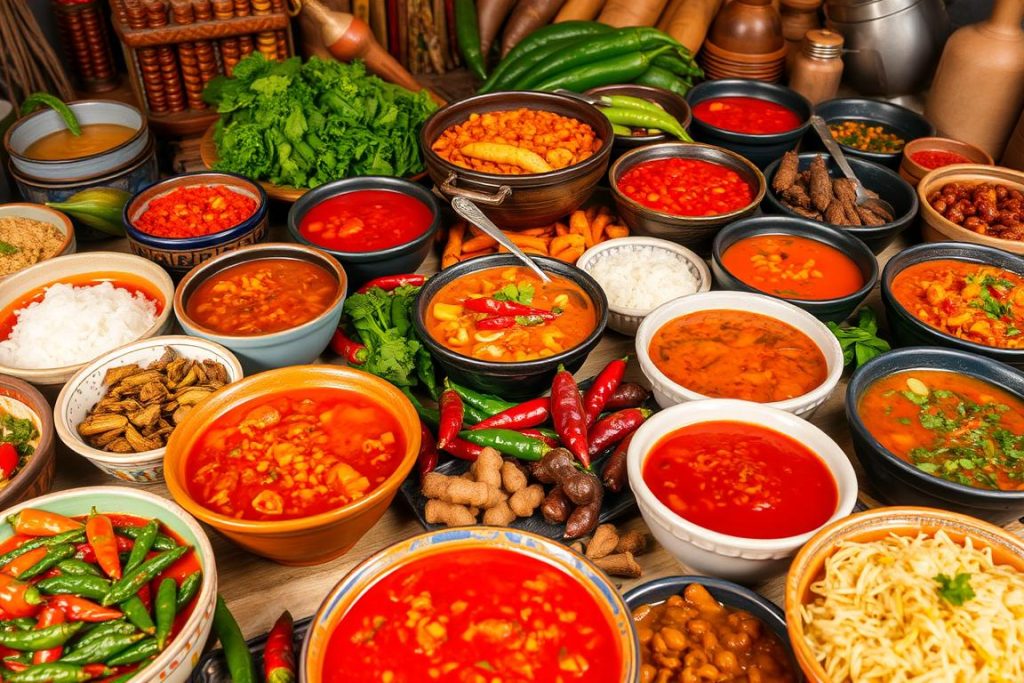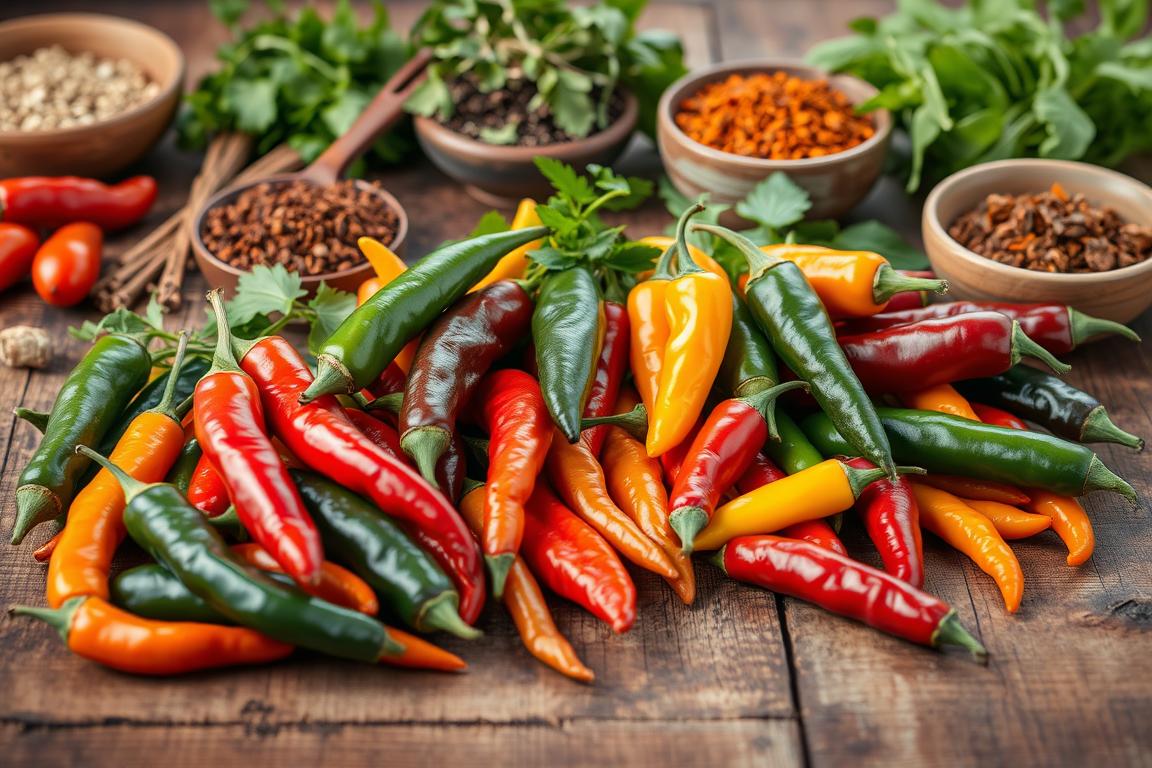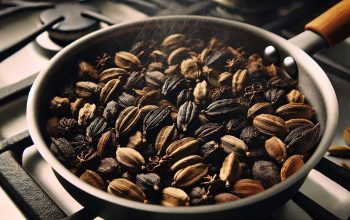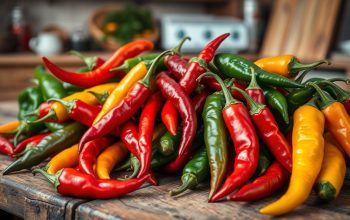Chili peppers open a world of flavors for food lovers. They can turn simple dishes into amazing meals. The secret is finding the right mix of heat and aroma.
Chili peppers are key in many cuisines, adding unique tastes to dishes. Whether you’re a pro chef or a home cook, learning to use chili can expand your cooking skills. This guide will cover the basics of working with chili, including different types, the Scoville scale, and what makes chili special.
We’ll also talk about the tools and techniques you need to use chili to its fullest. You’ll learn how to pick and store peppers and control the heat. This will help you make your dishes more flavorful and exciting.
If you love Mexican chili or want to try different chili sauces and marinades, this guide is for you. Get ready for a cooking journey where heat and aroma are key. Your kitchen will become a place of vibrant flavors and chili-infused dishes.
Understanding the Fundamentals of Cooking with Chili
Chili peppers come in many flavors and heat levels. Each type has its own unique taste and heat. To cook with chili well, you need to know about the different peppers, their heat, and what makes them special.
Different Types of Chili Peppers
There are many chili peppers, from the mild Anaheim to the hot Habanero. Each has its own taste, like sweet or smoky. Knowing about these peppers can make your cooking better, helping you pick the right one for your recipes.
The Scoville Heat Scale Explained
The Scoville scale measures a pepper’s heat. It ranges from the mild Bell pepper to the very hot Carolina Reaper. Knowing this scale helps you choose the right heat for your dishes.
Chemical Compounds in Chili
Chili peppers have more than just capsaicin. They also have flavonoids, carotenoids, and other compounds. These add to their flavor and aroma. Understanding these compounds can make your chili dishes even better.
| Chili Pepper Variety | Scoville Heat Units (SHU) | Flavor Notes |
|---|---|---|
| Anaheim | 500 – 2,500 SHU | Mild, slightly sweet |
| Jalapeño | 2,500 – 8,000 SHU | Medium heat, grassy, earthy |
| Serrano | 5,000 – 15,000 SHU | Bright, with a fruity-floral aroma |
| Cayenne | 30,000 – 50,000 SHU | Bold, pungent, and slightly smoky |
| Habanero | 100,000 – 350,000 SHU | Intense heat with a citrusy, fruity flavor |
Essential Kitchen Tools for Preparing Chili Dishes
When cooking with chili peppers, the right tools are key. You’ll need protective gear and special cutting tools. These items ensure a safe and efficient chili-making process.
Protecting your hands is crucial when handling hot peppers. Use food-grade rubber gloves to keep your skin safe from capsaicin. These gloves also stop oils from getting into your eyes or face.
A good cutting board is vital for chili prep. Choose one made of wood or bamboo. These materials are durable and less likely to harbor bacteria. Don’t use the same board for chili peppers and other foods to avoid flavor transfer.
For slicing and dicing, a sharp chef’s knife or serrated utility knife is best. A sharp blade makes cutting peppers easier and mess-free. Keep your knives sharp with a knife sharpener.
| Kitchen Tool | Purpose |
|---|---|
| Food-grade rubber gloves | Protect hands from chili pepper oils |
| Wooden or bamboo cutting board | Durable and less likely to harbor bacteria |
| Sharp chef’s knife or utility knife | Precisely cut and dice chili peppers |
| Airtight storage containers | Preserve freshness and flavor of chili peppers |
Lastly, get airtight storage containers to keep chili peppers fresh. These containers lock in aroma and prevent drying out or losing potency.
With these essential tools, you’ll be ready to make delicious chili dishes with ease.
The Art of Selecting and Storing Fresh Chili Peppers
Learning how to pick and store fresh chili peppers is key to making delicious dishes. Whether you’re a pro chef or a home cook, knowing about pepper ripeness and storage is important. It can really enhance your cooking.
Ripeness Indicators
Choosing the right ripeness for fresh chili peppers is essential. Look for peppers that are firm and brightly colored. They should also be free of blemishes or soft spots.
The skin should look glossy, and the stem should be fresh and green. A slight give when you squeeze the pepper is okay, but it shouldn’t feel soft or mushy.
Storage Methods for Maximum Freshness
To keep your chili peppers fresh and flavorful, proper storage is crucial. Store them in the fridge in a paper or plastic bag, or an airtight container. Don’t wash the peppers before storing, as extra moisture can cause them to spoil faster.
For the best taste, use the peppers within a week of buying them.
Freezing and Drying Techniques
- Freezing: Chili peppers can be frozen for long-term preservation. Just wash, slice, and put them in an airtight container or freezer bag. Remove as much air as you can before sealing. Frozen peppers will last up to 12 months.
- Drying: Drying is another great way to keep chili peppers fresh. You can string whole peppers or slice them and lay them out on a baking sheet. Let them dry in a cool, dry place with good air flow until they’re completely dry. Dried chili peppers can be stored in an airtight container for up to 6 months.
By following these tips, you can enjoy the fresh flavors of chili peppers for a long time. This opens up a world of culinary possibilities.
Preparing Chili: From Fresh to Cooking-Ready
Learning how to prepare chili is key to making tasty dishes. It’s all about balancing heat and aroma. You’ll need to know how to cut and deseed chili peppers.
Begin by thoroughly washing the chili peppers under running water. This removes dirt and residue. Check each pepper for blemishes or bruises that could change the flavor or texture.
- Start by slicing the pepper lengthwise. This makes it easy to remove the seeds and membranes. They are the main sources of heat.
- Use a sharp knife or spoon to gently scrape out the seeds and white membranes. Make sure to keep the flesh intact. This helps control the level of spiciness in your dish.
- Roasting the chili peppers can add extra flavor. Place them over an open flame or under a broiler. Turn them occasionally until the skin is lightly charred.
By following these chili preparation steps and cutting techniques, you’ll make vibrant, deseeded chili dishes. They will surely please your taste buds.
Mastering Heat Levels in Your Cooking
Making tasty dishes with chili peppers is all about finding the right balance. You need to control the heat and mix flavors well. This way, you can make your dishes stand out.
Controlling Spiciness
To manage heat, you must know the Scoville scale and the different types of chili peppers. Choose your chili peppers wisely to adjust the spiciness. Use milder peppers for a gentle warmth or hotter ones for a stronger kick.
Balancing Flavors
Chili peppers add more than just heat to your dishes. They bring a range of flavors that can either enhance or overpower your dish. To get the flavors right, pair chili peppers with ingredients that complement them. For example, red bell pepper can soften the heat of a jalapeño, while cumin can enhance the smokiness of chipotle chilis.
Emergency Heat Reduction Methods
- If your dish gets too spicy, add dairy like yogurt or sour cream to cool it down.
- Use acidic ingredients like citrus or tomatoes to balance the heat.
- Add a bit of honey or maple syrup to sweeten and reduce the spiciness.
- Dilute the dish with more broth or water to lessen the chili pepper’s impact.
By learning how to control spiciness, balance flavors, and reduce heat, you can take your chili dishes to the next level. Your guests will love the perfect mix of heat and aroma in your creations.
Traditional Mexican and Tex-Mex Chili Applications
The world of Mexican and Tex-Mex cuisine is full of chili-based dishes. These dishes, from chili con carne to enchiladas, show how versatile chili can be.
Chili con carne is a staple in Tex-Mex. It’s a stew with tender beef, savory spices, and chili peppers. It’s loved for its warmth and is perfect for any occasion.
Enchiladas are a Mexican favorite. They are tortillas filled with meat or veggies, covered in a chili sauce. They are a true delight for the taste buds.
Salsas are essential in Mexican and Tex-Mex dishes. They add flavor to many dishes. From tomato-based to habanero, they enhance the taste of chili-based foods.
| Dish | Key Ingredients | Preparation Method |
|---|---|---|
| Chili con Carne | Beef, chili peppers, tomatoes, onions, garlic | Slow-simmered stew |
| Enchiladas | Tortillas, chili sauce, cheese, meat or vegetable filling | Rolled and baked |
| Salsa | Tomatoes, onions, chili peppers, cilantro, lime juice | Chopped and mixed |
Mexican and Tex-Mex cuisine celebrate chili peppers. From chili con carne to enchiladas and salsas, these dishes highlight the art of cooking with chili.
Creating Signature Chili-Based Sauces and Marinades
Take your cooking to the next level by learning to make homemade hot sauces and chili-based marinades. These skills are great for both experienced chefs and home cooks. They add the perfect mix of heat and aroma to your dishes.
Hot Sauce Fundamentals
The key to a great hot sauce is choosing and preparing your chili peppers well. Try different types like habanero and jalapeño to find your favorite flavor. Understanding the Scoville scale helps you get the right amount of heat in your sauces.
Marinade Combinations
Chili-based marinades make your proteins and veggies tender and full of flavor. Mix chili peppers with seasonings, acids, and oils to create amazing flavors. You can use lime and garlic or chipotle and brown sugar for a unique taste.
Preservation Methods
- Bottling and Canning: Keep your homemade sauces and marinades fresh by using proper bottling and canning methods.
- Freezing: Freeze them in airtight containers or silicone trays to make them last longer.
- Dehydrating: Turn your sauces and marinades into powders or flakes. These can be easily rehydrated or used as dry rubs.
Get creative and improve your cooking by mastering the art of making chili-based sauces and marinades. Try different flavors, learn how to preserve them, and see how these hot sauce and marinade essentials can change your dishes.
Safety Measures When Handling Hot Peppers
Cooking with spicy peppers adds depth and flavor to dishes. But, it’s key to follow safety steps when using these ingredients. Knowing about pepper safety and how to protect your skin and eyes is important for any chef.
Proper Protective Gear
Wear protective gear when working with hot peppers. Gloves, like nitrile or latex, prevent capsaicin burns. Also, avoid touching your eyes, nose, or mouth to avoid irritation from pepper oils.
First Aid for Capsaicin Exposure
- Wash your skin with soap and cool water if it touches hot pepper oils.
- Flush your eyes with water for 15 minutes if they get exposed. See a doctor if irritation doesn’t go away.
- If you eat too much of hot peppers, drink milk or sugar to lessen the heat.
| Pepper Type | Scoville Heat Units (SHU) | Safety Considerations |
|---|---|---|
| Jalapeño | 2,500 – 8,000 SHU | Wear gloves when handling, avoid touching face |
| Habanero | 100,000 – 350,000 SHU | Extreme caution required, use well-ventilated area |
| Ghost Pepper | 855,000 – 1,041,427 SHU | Specialty equipment and protective gear essential |
By following these safety tips, you can enjoy hot peppers safely. A bit of pepper safety makes a big difference in spicy cooking.
Pairing Chili with Different Proteins
Creating tasty chili dishes is all about finding the right mix. This mix balances chili’s heat and aroma with the unique tastes of proteins. Whether you like beef, pork, poultry, fish, or vegetarian options, there’s a chili pairing for you.
Beef and Pork Combinations
For a classic chili con carne, use bold chili peppers with ground beef or chuck roast. This combo is hearty and satisfying. You can also try pork shoulder or ground pork for a twist, making it just as delicious.
Poultry and Fish Applications
Chili doesn’t have to be just about red meat. Chicken and turkey add a lighter, yet flavorful touch. White fish like tilapia or cod can also make a refreshing and nutritious chili.
Vegetarian Options
- Beans: Chili and beans are a perfect pair. Try different beans like black, kidney, or pinto for your vegetarian chili.
- Tofu: Firm or extra-firm tofu is great as a protein substitute. It soaks up chili’s bold flavors well.
- Lentils: Lentils add a satisfying texture and plant-based protein to chili pairings.
| Protein | Chili Pairings | Flavor Profile |
|---|---|---|
| Beef | Ancho, chipotle, or jalapeño chili | Rich, savory, and comforting |
| Pork | Habanero or Serrano chili | Spicy, bold, and versatile |
| Chicken | Cayenne or New Mexico chili | Lighter, yet flavorful |
| Fish | Guajillo or Pasilla chili | Refreshing and delicate |
| Beans | Chipotle or Ancho chili | Hearty, protein-rich, and satisfying |
By trying different protein combinations with the right chili peppers, you can create a flavorful symphony. This will take your chili dishes to a whole new level.
Regional Chili Cooking Styles Around the World
Chili peppers add a burst of flavor to many dishes worldwide. They are key in both Asian curries and South American stews. This shows how chili peppers can change the taste of food in different places.
In Asia, chili peppers make dishes like Thai red curry and Korean gochujang bold. They mix well with spices, citrus, and umami. This creates a rich taste experience.
In Africa, chili peppers give dishes a unique kick. Moroccan harissa and Egyptian dukkah use them with spices and nuts. West African dishes like jollof rice and egusi soup also feature chili peppers.
South America has its own chili-based dishes too. Mexican moles and Peruvian aji sauces are famous. They highlight the importance of chili peppers in South American cooking.
| Region | Signature Chili-Based Dish | Key Characteristics |
|---|---|---|
| Asia | Thai Red Curry | Creamy coconut milk, lemongrass, kaffir lime leaves |
| Africa | Moroccan Harissa | Chili peppers, garlic, caraway, coriander, cumin |
| South America | Peruvian Aji Sauce | Chili peppers, lime juice, cilantro, garlic |

Chili peppers are a big part of global cuisine. They add flavor to dishes from Asia to South America. This shows how versatile and tasty chili peppers can be in different dishes.
Common Mistakes to Avoid When Cooking with Chili
Cooking with chili peppers can be very rewarding. But, it’s important to avoid some common mistakes. These include preparation errors and seasoning problems. Learning to avoid these can make your chili dishes much better.
Preparation Errors
One big mistake is not properly seeding and de-veining chili peppers. This can make your dish too spicy. Also, not wearing gloves when handling hot peppers can cause skin burns. This is a quick way to ruin your cooking experience.
Cooking Missteps
Overcooking chili can make the flavors dull and the texture mushy. Not letting the chili simmer long enough can also cause problems. It’s important to control the cooking time and temperature to get the perfect chili.
Seasoning Problems
Not adjusting seasoning levels during cooking can result in a dish that’s too bland or too spicy. It’s key to taste and adjust the seasoning regularly. This includes salt, spices, and any other ingredients. This ensures your chili is balanced and flavorful.



